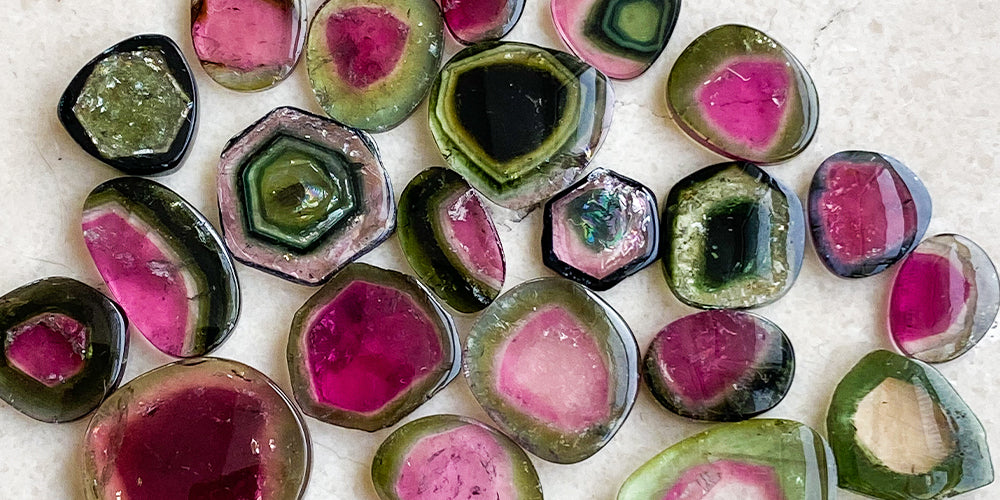My Inspiration
The first time I saw a tourmaline gem, I couldn't identify it. I was looking in the window of a tiny shop in Tel Aviv where I saw a necklace with a flat stone set in gold. The stone looked like a slice of watermelon, green rind and red interior, a most unusual and gorgeous combination. I asked the shopkeeper about it, and she said that it was a slice of “Watermelon Tourmaline”. I was so entranced that I immediately began to look for sources from whom I could buy Watermelon Tourmalines for use in my own creations. After much online research, I found a reliable source in Jaipur, India who could provide not only watermelon tourmalines, but also other tourmalines in a beautiful array of colors that all are natural and untreated. I also wanted to know more about Watermelon Tourmalines, and Tourmalines in general. Here is what I discovered!
Fun Fact: Tourmaline is an October Birthstone
While Opal is a popular and traditional birthstone for October, Pink Tourmaline is also considered an October Birthstone alongside Opal. As noted by this guide to gems and birthstones from the UNL School of Natural Resources, Jewelry Industry Council recommended that pink tourmaline be considered an alternate October birthstone to opal in 1952. While the birthstone designation originally specified pink tourmaline, many now accept any color of tourmaline for October's birthstone.

What is Tourmaline?
Tourmaline is the name of a large group of boron silicate minerals. These minerals share a common crystal structure and similar physical properties but vary tremendously in chemical composition. The wide range of compositions and color zoning within crystals causes tourmaline to occur in more colors and color combinations than any other mineral group. Tourmaline is characterized by elongated crystals. Tourmaline has a Mohs Scale hardness of 7 to 7.5, slightly harder than quartz (diamonds are a 10).

What Color is Tourmaline?
Black is the most common color of tourmaline, but tourmalines also occur in blue, green, yellow, pink, red, orange, purple, brown, and colorless—every color of the spectrum. Single crystals are often color-zoned.
“Watermelon tourmaline” is the most popular bicolor tourmaline. It has a pink interior and a green rind—just like a slice of watermelon. Other bicolor tourmalines include Indicolite (bluegreen) and Rubellite (pink-red).
Crystals may be green at one end and pink at the other, or green on the outside and pink inside; this type is called watermelon tourmaline and is prized in jewelry.
Where is Tourmaline Found?
Brazil has been the world's leading source of tourmaline for nearly 500 years. In the 1500s Portuguese explorers obtained green and blue tourmaline from indigenous people and from panning streams in search of gold. Beginning in the late 1800s, a steady stream of tourmaline discoveries have been made in the Minas Gerais, Brazil, produced in a wide range of colors, including much bicolor material. This diverse stream of tourmaline from Brazil has been the most important source for the worldwide gem and jewelry market.
Over the past 200 years, significant amounts of pink and green tourmaline have been produced from dozens of Maine localities, and in the late 1800s in southern California, especially pink and minty green tourmaline.
Today, discoveries of tourmaline of various kinds are made in Afghanistan, Mozambique, Namibia, Nigeria, Pakistan, Tanzania, the United States and other countries. These provide the market with a constantly changing supply of gem tourmaline and mineral specimens.
Gem and specimen tourmaline is mined chiefly in Brazil (every color) and many parts of Africa, including Tanzania, Nigeria, Kenya, Madagascar, Mozambique, Malawi, and Namibia. It is also mined in Asia, notably in Pakistan, Afghanistan, and Indonesia as well as in Sri Lanka and India.
Is Tourmaline Expensive?
Tourmalines are readily available, with small tourmalines (under 5 carats) not hard to find at reasonable prices. Larger sizes, unusual colors and fine specimens can range up to a few hundred dollars per carat.

How is Tourmaline Used in Jewelry-Making?
Tourmaline can be cut in a variety of ways for inclusion in pendants, earrings, rings and other jewelry. Cuts include:
- Faceted, in any shape
- Slices, flat
- Polkis, flat with light faceting
- Rods, which are natural crystal rods cut into smaller sections
In my designs for RTJ, I generally use “polki” cuts or tourmalines cut into tiny six-pointed stars, which you can see in the Unearthed Treasures collection.
Tourmaline Pendants and Necklaces
Here are some examples of jewelry with tourmaline stones:

Blue Green Tourmaline Jewelry

"Sea of Blue" Tourmaline Necklace
A refreshing natural Indigo Tourmaline gem is set in burnished 18k gold, suspended with double loops from a delicate 18k gold chain.
Watermelon Tourmaline Jewelry

Watermelon Slice Tourmaline Pendant
Help yourself to a mouth-watering slice of brilliantly hued Watermelon Tourmaline, a one-of-a-kind natural gem set in 14k gold, suspended from a delicate 14k gold chain.
Bicolor and Striped Tourmaline Jewelry

Striped Gem Tourmaline Pendant
Pinks and greens complement each other in a uniquely striated natural Tourmaline gem, hand set in burnished 14k yellow gold.

Safari Striped Tourmaline Pendant
Embracing its wanderlust, this natural and untreated hand-cut green and striped Tourmaline features a faceted polki cut. Hand-set in 14k yellow gold, and designed with an open back setting that allows the light shines through. Dangling from a 14k yellow gold chain, adjustable in length offering an elongated effect.


